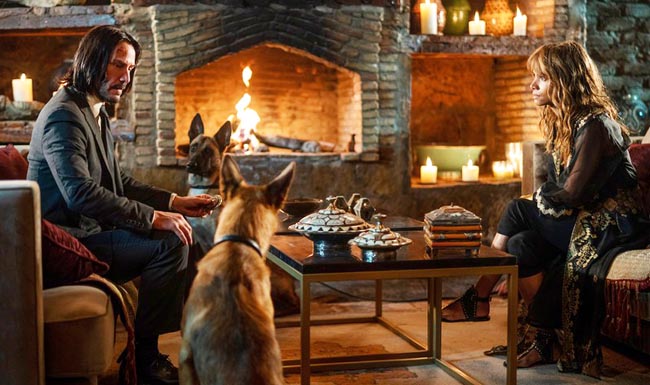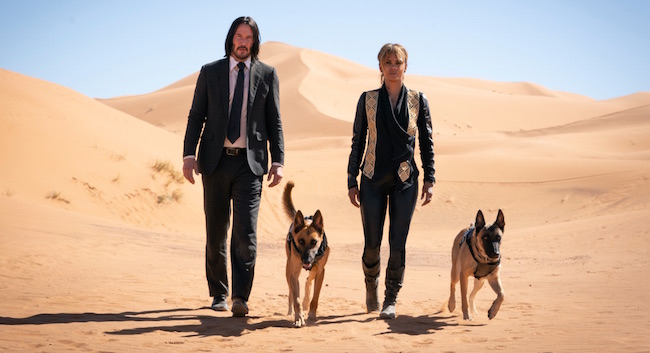
John Wick 3 director Chad Stahelski has led an interesting life. He’s been an MMA fighter, trained Irish wolfhounds with his mother, raced motorcycles, and been a professional rock climber. He went to the same martial arts academy as Brandon Lee and did stunt work to help finish The Crow after Lee was killed in an accident on set. Later he worked with the Wachowskis and doubled for Keanu Reeves on The Matrix.
In 2013 Stahelski and David Leitch pitched the idea for John Wick, which they ended up directing. It was a surprise hit, grossing $88 million worldwide on a $20 million budget. A sequel followed, directed by Stahelski, in 2017, with double the budget and more than double the gross, $171 million worldwide. Part three has already grossed $182 million worldwide and is still going strong.
The plots have gotten bigger along with the budgets, and what started as a revenge movie centered around a dog’s murder now encompasses an underworld corporate hierarchy and an entire shadow economy of ancient coins representing blood oaths. As you might expect from a stunt coordinator-turned-director, the stunts have continued to push the envelope as well. This chapter of John Wick featured a murder-by-book and an entire fight scene incorporating crotch-biting dogs.
Believe it or not, getting dogs to do that on film is a lot more complicated than simply yelling “Chopper, sic balls!” like in Stand By Me. It’s a process, which in this case took years to complete, and involved training the dogs from the time they were puppies specifically for the purpose of using them in this film.
I recently spoke with Stahelski, who, much like the John Wick character himself, seemed especially concerned about the safety of dogs for a guy who wrote a scene where someone gets curb stomped on a book.
So I’m just going to come right out and ask it: are you the best working director named Chad?
I don’t know if I’m the best. I don’t know too many other Chads, so I’ll claim singularity, but I won’t claim greatness. How’s that?
That works for me. So tell me about the scenes with the dogs. Like, how did that come about, and how did you pull it off?
I love dogs. I have two. John Wick is kind of a dog movie, obviously. You know, it’s a concept I had. As a stunt-person, as a stunt coordinator, I’ve done a lot of directing, and stunts with animals and the way they do it is fairly archaic. When you see a dog attack a human being, the dog doesn’t know it’s a movie. The animal is just trying to injure a human being. And that doesn’t sit well with us, I guess.
Having dogs myself and having my mom raise Irish Wolfhounds as a kid, I was always around training animals, and we wanted to do something different. We wanted to actually train the dogs to be part of the choreography. I had the idea for number 2, but it just didn’t come out, it didn’t work in the script, or we just didn’t have the time or the financial resources to actually execute it. So when we got to number three, it’s one of the first scenes I wrote. Like “no matter what we do on this movie, we’re doing dogs.”
So I contacted a bunch of trainers who didn’t really gel conceptually with what I was trying to get done. Bumped into Andrew Simpson, who does the wolves on Game of Thrones, thanks to a reference — everybody said this was the guy. Sure enough, Andrew’s like the dog whisperer, and I told him what I wanted to do, to train a team of dogs from scratch to be stunt dogs. Andrew came up with a method and a process to do that. He spent the next three months going around the United States, and found five Belgian malinois from different military installations where they were being boarded and started the process. Seven months it took to get the animals from, like, a year and a half old, to get the skill set, to get used to doing that. And it’s more than what you just see on camera. It’s the animals being on set, it’s being around gunfire, it’s having 20 stunt guys running, yelling, screaming. Two cameramen running around with these big, black boxes, chasing the dogs. The dogs have to stay focused and energetic… and also, you don’t want to hurt the puppies, you don’t want to hurt the stuntmen. It just takes a very meticulous process. They’re not like human beings, where you can just push eight hours a day of rehearsals. When a dog’s done, he’s done. You can do it with your own dog. He gets the stick once, he gets the stick twice, third time, dog’s looking at you like, “Yeah fuck off I already got it twice,” you know what I mean?
So it takes a longer timeline to get things done. And then most of the time you see animal stuff, the trainers are right behind the camera, or just out of frame so the trainer can control the animal and give the commands. We couldn’t do that, so the only way to do it was to have an on-camera trainer. So we literally had Halle (Berry) go for two to three hours of dog training every day — where she was actually coaching them, training them, commanding them. When Halle is on screen, that’s her actually giving the commands to the dogs. And that just takes a massive amount of time. Like we would say, there’s no such thing as a movie dog. You get a dog and you have to train it from scratch. So we took notes from how the military trains their dogs, how SWAT teams and bomb-disposal units train their dogs. We kinda took those methods and ran with it.
So when you say that the dog normally doesn’t know it’s in a movie, the main difference is that the person training the dog, in this case, is actually on screen?
That, yes, and normally when you get an animal, when you train an animal to attack, the trainer or stunt-person is in protective gear and the animal is actually trying to hurt them. We didn’t want our animals to try and hurt anybody, so we trained them, like, you know when you play with a dog, and he gets a sock, or he gets the ball and you try and take it away the dog’s not trying to hurt you, he’s just trying to play with the ball. But what happens if your dog starts getting too rough with you? “Whoa, hey, easy, boy, no don’t do that” cause you don’t want it messing with your kids or somebody else that way, right? We took the opposite approach and encouraged aggressive playtime.
Ah.
So it’s playtime but we’re reinforcing that it’s okay to play rough with the stunt guys. And what you don’t see, we put certain kinds of targets on the stunt guys, which we later digitally erase, so when the animal sees the green fluffy toy on the stunt guy, he knows to go get that fluffy toy. And what you see is not him attacking the stunt guy, he’s just trying to get his toy. The dog is trying to rip the toy off the stunt guy, and then we digitally erase that.
Right. So do they have the toy in the crotch area? And then is there special gear underneath that the stunt guy has to wear to make sure he doesn’t get his balls bitten off?
We have certain kinds of… again, it’s tricky cause you don’t want to hurt the doggies’ teeth, so it’s a soft kevlar kind of padding. There’s special shorts and pads we wear so that the dog can’t bite through but at the same time it doesn’t hurt the dog’s teeth.

Okay, so in terms of your background: how does one become a stuntman?
That’s a really good question, it’s funny no one ever asks.
Really?!
But to answer, in different countries there are different methods. Some countries, like in England, you have to be certified. You have to do all these courses and stuff. In America, right now, you could say you’re a stunt guy. That doesn’t mean anyone will hire you, but you can be a stunt guy.
Oh.
You just have to join SAG. Then you’re a stuntman. Now, to be a working stuntman, professional stuntwoman, somebody who works, it takes, minimum, three to five years to understand the business, and for people to get to know you. It’s a very competitive market. So you’re coming up against professional martial artists, choreographers, Olympic gymnasts, X-games champions, everybody’s got something different.
Then there’s what we call ND — that’s non-descript stuntmen. Those are like a good high school or collegiate athlete, all-around athlete, not a specific skill set but just very athletic and understands the business, is a good actor, performer — because acting is about half of being a stunt performer. Sometimes people get in because they’re a really good race car driver or they’re a professional motorcross guy. They have a skill set that lends itself to the business. Usually, in the top, you know, anywhere from five to ten percent of that field. Top ten Olympic gymnasts, top ten martial art guys, top ten high-fall guys or high-divers or race car guys or GP racing on a motorcycle. That’s usually the number one way people get in, they have a very specific skill set.
So what was your in? What was your background or your special skill?
I was a martial artist. I was trained in a lot of different martial arts from an early age. Had a very eclectic upbringing. I was trained very professionally from a very early age, just because of particular coaches and where I grew up. So by the time I had come to California, I was already competing professionally in certain martial arts, and I would like to think it was fairly decent what I did. People saw me compete and put on a demo, there were some stunt coordinators in the audience. They came up to me after and asked if I was interested in working stunts. They didn’t know, but at the time I’d already been a competitive rock climber, I was already racing motorcycles, I was already in gymnastics. I was just an athletic kid, and both my parents were athletes so I had a background that lent itself to that.
What were your martial arts?
I started at 10 when I was in judo. Then I went into different styles of karate and Japanese jiu jitsu, and went very heavily into that. Later from age 17 on, I hooked up with a guy named Dan Inosanto, who’s a very famous martial arts instructor here in California. And he sent me all over the world learning anything from Muay Thai to Savate — that’s French kickboxing — the Filipino martial arts, Pencak Silat, which is Indonesian, as well as Brazilian jiu-jitsu. So you know, it was like college of martial arts for 10 years. I probably would either be working in a gas station or then a fairly decent criminal, or a, you know, job in Hollywood, which is probably what I was best suited for.
How have you seen the action film evolve since the time you started until now?
You know, it depends on your perspective of that. Like, Asian cinema was way ahead of us back in the ’90s. Hong Kong filmmaking, the high points of Jackie Chan, Sammo Hung, Jet Li, Donnie Yen, you know, those guys, back in the Hong Kong action director days. Ringo Lam, John Woo, Woo Ping, all these great action directors and directors that were into action, that was a big thing. In the West, we were a little behind, we were still doing big muscles and big machine guns. Now we’ve kind of caught up. But before The Matrix came out, martial arts and action were considered more of a low class, low budget genre.
Right.
Cut to, they come out with The Matrix, all of a sudden “oh shit, this is a big budget, high concept film with actual kung-fu in it.” That changed everything. After that, martial artists became the more sought-after type of stuntmen, because there weren’t many of us, especially many of us who could choreograph — actually put moves together, relate that to the camera and help the director shoot it, as well as edit. The Matrix changed everything. After that, that slowly bled into the superhero craze where everything was wire work and every movie had to have a martial arts fight scene. And not only a martial arts fight scene, they want different styles, and how do we do something different? Okay, we don’t just want kicking, we want throwing, we want jiu-jitsu, and then, of course, the UFC and Brazilian jiu-jitsu took it to another level. I mean, 20 years ago, no one knew what an armbar was. If you did any judo throws, people would look at you like “that’s lame.” Now, everybody and their buddy knows what an armbar is.
So in terms of John Wick specifically, the world of it seems to have evolved quite a bit from the first one until now. Was that a plan that you always had, or did that sort of just grow out of having to make it bigger and continue the story?
At the risk of undermining my own creative integrity, there was no plan. We finished number one, and we were like, “We’re never going to work again.” And then they asked us to do two, like “holy shit we’re going to make number two!” Then we finished number two going, “Well we went pretty weird on that one, we’re never going to work again.” And then we were like “ah fuck we gotta come up with a number three.” We’ve never completed a single John Wick, including the number 3, planning to do a number 4, 5, or 6. It’s just, we try to make a good movie. We try to end it the way we think the endings would. I like broken rhythm. I don’t three acts, I like two acts. I didn’t design any of the John Wicks to be a cliffhanger. I just kind of end them, as you think you would. I like the trilogy The Man With No Name stuff, and if you watch those they’re fairly unresolved endings.
Yeah.
As far as going bigger, “How do we beat ourselves?” — that’s never been a concern. We just try to make what we think is the next chapter, just like we were writing a book. We don’t see anything as an ending, that’s why there are never chapters because, at the end of the day, John Wick’s fucked. He’s probably never going to ride off into the sunset. He’s got to pay for his sins, and that’s just the way it is.
Right. So Keanu’s sort of labored movements in John Wick 3, is that because he’s still sort of beat up and hurt from John Wick 2?
Exactly. We call it “The Theater of Pain.” Every time John Wick does anything, we want him to get his ass kicked a little bit. It’s to build empathy for the character, but it’s also John paying for his deeds.
Okay, so you’ve probably gotten this question a million times, but since we’re here, how much of that stunt work is actually Keanu?
Well, we kind of go out of our way to show you that it’s Keanu Reeves. We don’t choreograph it first and then stick Keanu in it. We work with Keanu to choreograph it, so we’re working with what he does very well and what he can get done. We don’t ever try to choreograph these really hard moves that he can’t do, just saying “put a double in.” I care about you believing it’s John Wick. Not you believing in the move or the choreography. So, yeah, in a fight sequence, in the running and the jumping, and the motorcycle stuff, yeah, that’s Keanu Reeves. He’s a great motorcycle rider, he’s better than most stunt guys. He’s a great fight guy too, better than most stunt guys. That’s all Keanu Reeves. You can see him get hit by cars though and that may not be him.
Right. So, in having all these movies take place in such a short time frame, does that mean that he’s going to have to have the same hairstyle for the next one? Or can you switch it up and have a John Wick where maybe he comes out with bangs or something?
It probably won’t be bangs or pigtails.
Okay. I mean, just a thought.
I think that if there was another John Wick, or if we’re involved with another John Wick, it would be very interesting to kind of break the timeline and find John Wick in a different point in his life. I think that’d be fun.
Vince Mancini is on Twitter. You can access his archive of reviews here.






